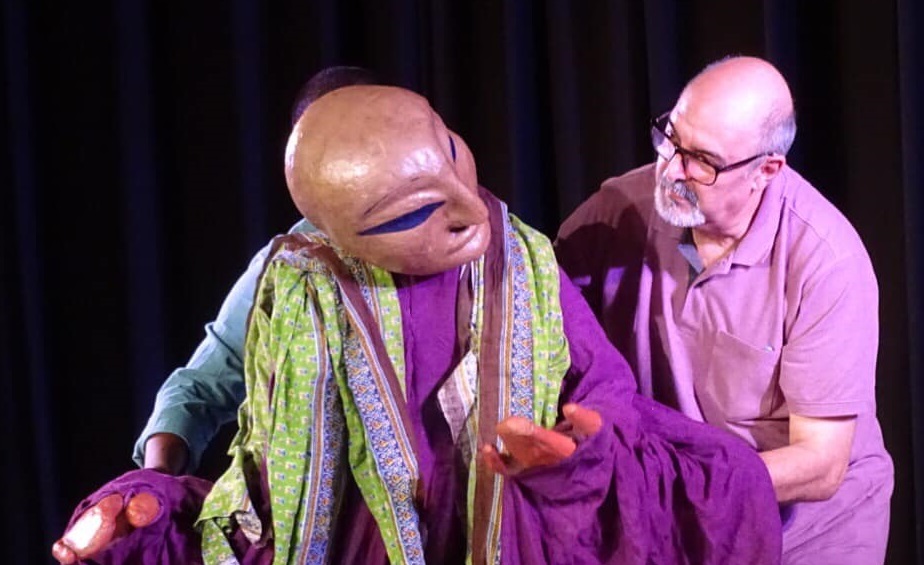Improvisations can be free-spirited as well as measured, as Dadi Pudumjee and Sindhe Sriramulu — two top Indian puppeteers of different genres and upbringing — prove.
On September 23, a week after his 69th birthday, Padma Shri Dadi Pudumjee shared a shade of his anxiety with fellow puppeteers the world over. It was over the prospect of his Delhi-based organisation holding the next edition of an annual event. The 19th Ishara International Puppet Festival isn’t sure of meeting its schedule in the second month of 2021. Reason: the spread of the dreaded coronavirus across the country and across continents “in these most strange times…,” he notes on Facebook. “…if not in February, then as and when it’s possible.”
A fortnight before this post, Pudumjee recalls a year-old trip his theatre group undertook to Russia. Its members had, in September 2019, performed in Moscow a production named ‘When Land becomes Water’. Here, again, he wistfully adds: “…after our 18th Ishara International puppet festival in February 2020, there has been no work or projects”. A nation-wide lockdown triggered since late March owing to Covid-19 has left “isolation” to be the highlight of all artists in India, he points out.
‘When Land becomes Water’ is an hour-long work that has an oceanic deluge effectively coming in as the central character. The show was presented in Mumbai—exactly one year before a Janata Curfew imposed in the country as a prelude to keeping people indoors across India to counter the pandemic. If Covid-19 triggered public debates about an increasing disregard modern life has for the environment, ‘When Land becomes Water’, too, was about mankind’s violent attitude towards nature. Designed and directed by Pudumjee, it, however, ends with a positive note.
Conservation of ecology is a subject that must be of critical interest to both children and adults. In any case, Pudumjee, a Sangeet Nataka Akademi awardee, doesn’t think his art-form is for kids alone. Traditional puppetries have invariably been people of all age-brackets, he substantiates with examples from southern India. That this art, with an antiquity of five millennia, is for little boys and girls to enjoy a “misconception”, he reiterated even amid the 18th Ishara festival (February 14-24) held in the national capital and Chandigarh further upcountry.
Aptly, Pudumjee, who did his higher studies in Ahmedabad (National Institute of Design and Darpana Academy of Performing Arts) and Sweden (Marionette Theatre Institute, Stockholm), goes beyond the conventional techniques of handy dolls moved with hands or strings. In fact, several of his characters on stage are occasionally appear larger than life, what with the deployment semi-sculptural puppets.
Such is the visual experience that the viewer finds the physique and face of the presenter and the puppet as one. That said, rods or gloves are no anathema. Overall, the style is essentially eclectic: intelligent lighting that enables processional figures to cast gripping shadows or even technologies banking on mixed media. Narration relying on poetry isn’t unusual, the musicality of their rendition is of high importance. Social issues are often Pudumjee’s themes of productions.
Bommalata youngster
Cut to Pune, where Pudumjee spent his formative years. The Maharashtra city in 2018—and in the puppeteer’s birth month—hosted a workshop by two young exponents of Tholu Bommalata. That is traditional shadow puppetry that flourished during Emperor Krishnadevaraya’s reign (1509-29) across the Deccan Plateau, but later went on to confined to parts of what is Andhra Pradesh in the southeast belt of independent India. (It’s another matter the history of shadow puppetry in the peninsula traces to the 4th century AD, when it was groomed under the Satavahana as well as Chalukya dynasties before spreading eastward to South East Asia.)
Sindhe Sriramulu
Sindhe Sriramulu, who was the junior in the pair that led the September 6-7 Pune workshop, is a key figure among those into Bommalata banking on Hindu mythology for themes. Mahabharata stories apart, this leather puppetry throws light primarily on the Ramayana. The medieval-era Telugu verses are from Ranganatha Ramayanamu (17,290 couplets) poet-ruler Gona Reddy penned during 1300-10.
Sriramulu lives in Anantapur district of Andhra Pradesh (though the ancestral moorings are in Marathwada). His Nimmalakunta village of Rayalaseema region has 40 families surviving on leather puppetry, earning the place (in 2008) a GI (geographical indication) tag that shows the product’s source. In his early 30s, Sriramulu strives to spread the aesthetics of the art where translucent puppets on rods filter the backlights on to the screen facing the audience. What’s more, he has to ensure that Bommalata has practitioners in the next generation to also keep its high-pitched vocals and cymbals-set percussion alive.
For all the puppetry-allied families in Nimmalakunta near Dharmavaram, only a dozen conduct shows. The rest are busy merely creating hand-painted puppets. In the new age, they use the goat-skin (basic input) to make images, wall-hangings, bookmarks and even lampshades that sell as ethnic exotica in cities. “For me as well, their market is the chief source of family income today”, says Sriramulu, a national award-winner. “Plus, the fees we get at workshops.”

